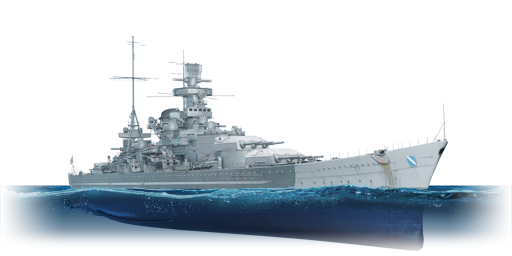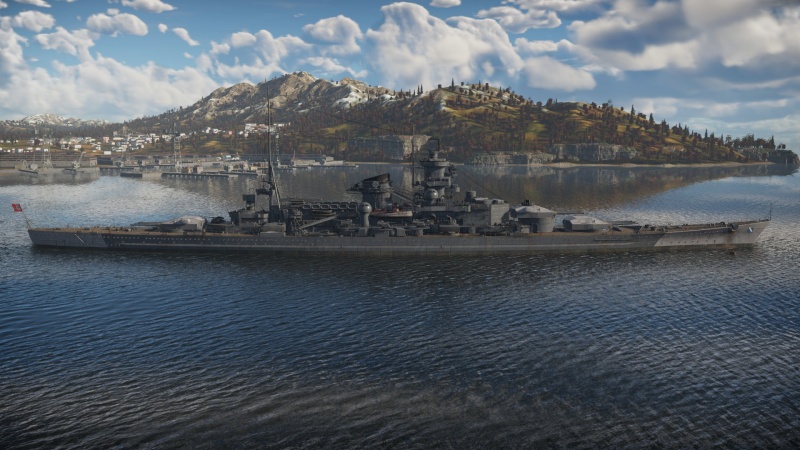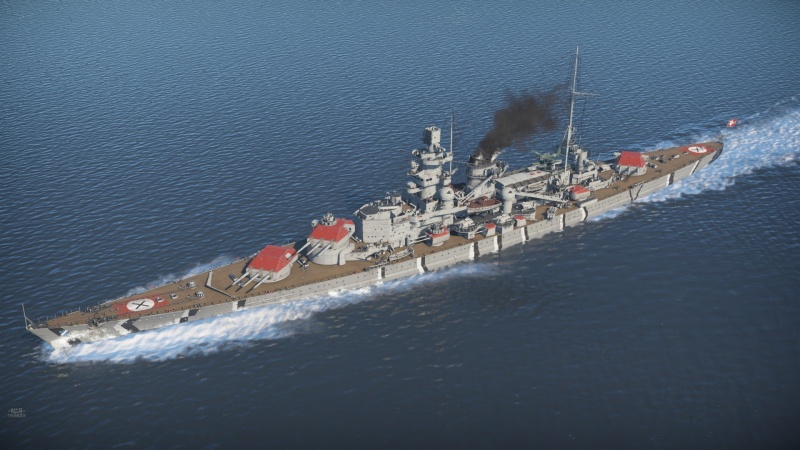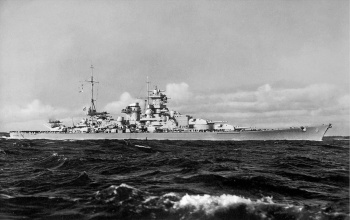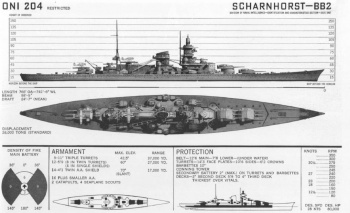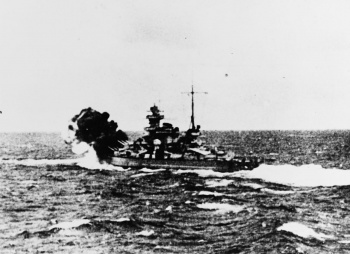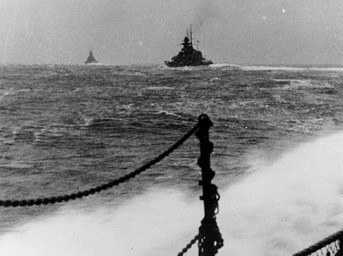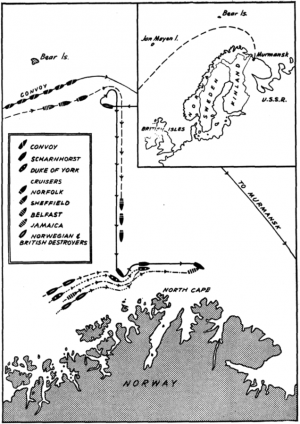Scharnhorst
Contents
Description
The Scharnhorst-class, Scharnhorst, 1943 is a rank VI German battlecruiser with a battle rating of 7.0 (AB/RB/SB). It was introduced in Update "Winged Lions".
General info
Survivability and armour
Talk about the vehicle's armour. Note the most well-defended and most vulnerable zones, e.g. the ammo magazine. Evaluate the composition of components and assemblies responsible for movement and manoeuvrability. Evaluate the survivability of the primary and secondary armaments separately. Don't forget to mention the size of the crew, which plays an important role in fleet mechanics. Save tips on preserving survivability for the "Usage in battles" section. If necessary, use a graphical template to show the most well-protected or most vulnerable points in the armour.
Mobility
Write about the ship's mobility. Evaluate its power and manoeuvrability, rudder rerouting speed, stopping speed at full tilt, with its maximum forward and reverse speed.
| Mobility Characteristics | |||
|---|---|---|---|
| Game Mode | Upgrade Status | Maximum Speed (km/h) | |
| Forward | Reverse | ||
| AB | |||
| Upgraded | 68 | 25 | |
| RB/SB | |||
| Upgraded | 59 | 22 | |
Modifications and economy
Armament
Primary armament
Provide information about the characteristics of the primary armament. Evaluate their efficacy in battle based on their reload speed, ballistics and the capacity of their shells. Add a link to the main article about the weapon: {{main|Weapon name (calibre)}}. Broadly describe the ammunition available for the primary armament, and provide recommendations on how to use it and which ammunition to choose.
Secondary armament
Some ships are fitted with weapons of various calibres. Secondary armaments are defined as weapons chosen with the control Select secondary weapon. Evaluate the secondary armaments and give advice on how to use them. Describe the ammunition available for the secondary armament. Provide recommendations on how to use them and which ammunition to choose. Remember that any anti-air armament, even heavy calibre weapons, belong in the next section. If there is no secondary armament, remove this section.
Anti-aircraft armament
An important part of the ship's armament responsible for air defence. Anti-aircraft armament is defined by the weapon chosen with the control Select anti-aircraft weapons. Talk about the ship's anti-air cannons and machine guns, the number of guns and their positions, their effective range, and about their overall effectiveness – including against surface targets. If there are no anti-aircraft armaments, remove this section.
Additional armament
Describe the available additional armaments of the ship: depth charges, mines, torpedoes. Talk about their positions, available ammunition and launch features such as dead zones of torpedoes. If there is no additional armament, remove this section.
Scout plane
Located amidships is a single catapult for an Arado Ar 196 scout plane which provides unique offensive and defensive abilities, expanding tactical options. Ship-launched scout planes fly just like regular tree units but lack munition choices and cockpit views. Alongside the typical abilities of strafing, dropping 2 x 50 kg bombs, and capping zones, the Ar 196 and other scout planes have the added ability to lay down smoke cover (up to 3 times). It is essentially the event aircraft except with smoke generators, so it will be a familiar unit for those who have the event version. Captains will be wise to remember to utilise the aircraft and consider when best to use it, for example to cap a point early or late in the match, to create a smoke screen to stymie enemy bombardment and repair, to attack enemy units directly, or perhaps something completely new! The threat of bombers carrying many large bombs is significant, so using the Ar 196 as top cover can also be considered, though its effectiveness may be limited.
Usage in battles
Describe the technique of using this ship, the characteristics of her use in a team and tips on strategy. Abstain from writing an entire guide – don't try to provide a single point of view, but give the reader food for thought. Talk about the most dangerous opponents for this vehicle and provide recommendations on fighting them. If necessary, note the specifics of playing with this vehicle in various modes (AB, RB, SB).
Pros and cons
Pros:
- Big guns on a fast cruiser hull
- One scout seaplane
- Fast reload speed for main guns of this calibre
- Effective AA capability
- Secondary guns are effective when up close
Cons:
- Big target, next to impossible to miss, either for guns or torpedoes
- Slow turret traverse speed
- 40% of the secondary guns aren't dual-purpose, which limits your AA capabilities
History
The Scharnhorst was a German battlecruiser (or battleship depending on classification) that served in WWII, the lead ship of her class.[1] Designed to counter the French Dunkerque-class battleships, Scharnhorst was a significantly-enlarged and improved development on the previous Deutschland-class pocket battleships (“panzerschiffe”).[2] Scharnhorst operated with her sister ship Gneisenau during the early years of WWII, wreaking havoc on allied shipping. However, she ultimately met her demise at the Battle of North Cape, where she was sunk by a large British force led by the battleship HMS Duke of York.[3]
Design and development
Following the end of WWI, Germany's navy was significantly reduced by the Treaty of Versailles, which prevented Germany from owning any modern battleships.[2] As a result, the German Navy (Kriegsmarine) pursued an innovative type of vessel: pocket battleships ("Panzerschiffe": armoured ship) that were small enough to be classified as cruisers, but carried battlecruiser-calibre armament.[2] And thus, Germany built three ships of the Deutschland class of "pocket battleships", armed with six 11-inch (283 mm) guns and displacing ~10,000 tons each. However, these ships were still inadequate to deal with the Royal Navy's battlecruisers, as well as the new French fast battleships Dunkerque and Strasbourg.[2][3] Following the negotiation of the Anglo-German naval agreement, allowing battleship construction, the German government cancelled the 4th and 5th ships of the Deutschland-class and proceeded with a new design.[2]
The new ships were significantly larger and better-armoured than the pocket battleships. Scharnhorst had a displacement of 32,100 tons standard and 38,100 tons fully loaded: a ~20,000-ton increase from the Deutschland class.[3] The ships retained the 11-inch guns of the Deutschlands but gained a third triple turret, bringing the total to 9 guns. While these guns were quite impressive, with a 17-second reload time, they were limited in effectiveness against the armour of enemy battleships.[2] As a result, the ship was designed to be rearmed with 15-inch (381 mm) guns in dual turrets, but the opportunity for this refit never arised.[1] In addition to the main guns, Scharnhorst had twelve 5.9-inch (150 mm) guns mounted in amidships turrets.[2] Anti-aircraft armament consisted of fourteen 4.1-inch (105 mm) dual-purpose guns in twin turrets, sixteen 37 mm and ten (later sixteen) 20 mm anti-aircraft guns.[1] Scharnhorst had two Seetakt radars for fire-control, with a range of ~16 km.[4] She could also carry multiple Arado 196 seaplanes for longer range reconnaissance.[3]
Scharnhorst was designed with a heavy armour belt, up to 12.5 inches of Krupp cemented armour at the waterline.[3] Her main gun turrets had up to 14.3 inches of armour while her deck had up to 5.9 inches of armour. Scharnhorst was massive, at 234 m long,[4] and had a crew of 1,840 men.[1] Her three steam turbines allowed a maximum speed of 31 knots (58.3 km/h), though at this speed, the ship was unmanoeuvrable: during her sea trials in 1939, Scharnhorst took on so much water through the bow that a refit was necessitated: her bow was redesigned with a flared "clipper-style" bow that prevented the forward "A" turret from firing at 0-degree elevation.[3][4]
Operational service
Scharnhorst was ordered in January of 1934 and her keel was laid on June 15th, 1935.[3] Scharnhorst, and her sister Gneisenau, were named after a pair of armoured cruisers sunk at the Battle of the Falkland Islands during the First World War.[2] Scharnhorst was launched on October 3rd, 1936, with Adolf Hitler himself in attendance. She was completed in January of 1939 and entered service under the command of Captain Otto Ciliax.[3]
Early combat service
Scharnhorst saw her first combat action with Gneisenau in November 1939, when the pair of battlecruisers spotted the British merchant cruiser HMS Rawalpindi.[2][3] Despite seeing signals from Scharnhorst to stop and abandon ship, the cruiser decided to valiantly fight on, even as the German battlecruisers possessed a combined eighteen 11-inch guns.[3] After a brief engagement, the Rawalpindi was sunk, and only 38 crew members survived from the crew of 276. Scharnhorst and Gneisenau then escaped in a squall, pursued by British battleships Warspite, Hood, and Repulse, who had sailed in to aid the Rawalpindi.[3]
In 1940, Scharnhorst participated in the invasion of Norway, where she had a short engagement with the British battlecruiser HMS Renown.[2] This combat resulted in heavy seas-related flooding to Scharnhorst which put her "A" turret out of action; Scharnhorst spent the month of April 1940 in drydock for an overhaul to her gunnery and propulsion systems.[3] Two months later, Scharnhorst and Gneisenau stumbled into the British light carrier HMS Glorious along with her escorting destroyers Ardent and Acasta. In the ensuing battle, all three British ships were sunk, with the loss of 1,519 men.[3] During this engagement, Scharnhorst set a record for the longest range naval gun hit ever recorded, having hit HMS Glorious from a range of 24 km.[5] However, Scharnhorst was hit by a torpedo from Acasta, resulting in the deaths of 50 sailors and severe flooding which put the "C" turret out of action.[3][4] Scharnhorst spent the next five months in drydock for repairs.[3]
Atlantic raids and Channel Dash
In January of 1941, Scharnhorst and Gneisenau broke out into the Atlantic to begin a raid on Allied merchant shipping.[2] During this raid, Scharnhorst sank a total of 9 ships totalling 50,588 tons, while the two ships together sank over 110,000 tons of Allied shipping. Both ships arrived at Brest in late March.[3] The ships were to participate in a massive Kriegsmarine attack in May 1941 alongside the newly-commissioned battleship Bismarck in the Atlantic.[2] However, British aerial raids on Brest resulted in Scharnhorst and Gneisenau being put out of action.[2] Bismarck would ultimately conduct the raid escorted by the cruiser Prinz Eugen, with disastrous results.
In late 1941, Scharnhorst, Gneisenau, and Prinz Eugen were holed up in Brest, an unfavourable position given that British bombers conducted regular attacks.[2] As a result, a daring plan was created, for the three capital ships to sail through the English channel in broad daylight, codenamed Operation Cerberus.[3][4] All three ships made it through the channel, though Scharnhorst hit two mines and an E-boat was lost.[2][4] The dash was a great embarrassment to the British Navy and Air Force, as 242 bombers had attempted to destroy the German force.[3]
Battle of North Cape
Scharnhorst would remain at Kiel for most of 1942, and in early 1943, she sailed with the cruiser Prinz Eugen to Norway to join the battleship Tirpitz.[2] It was with the German Norway squadron that Scharnhorst would meet her demise. In December of 1943, Scharnhorst attempted another sortie into the North Atlantic.[4] However, the British had intercepted German radio messages and were fully aware of what was happening. They sent Convoy JW 55B as bait, with an additional three cruisers as reinforcement. Admiral Bruce Fraser's main fleet, sent to intercept and sink the Scharnhorst, was composed of the battleship Duke of York, heavy cruiser Jamaica and four destroyers.[4]
At 09:00 AM, Scharnhorst contacted the British cruisers Norfolk, Belfast and Sheffield.[3] Both sides exchanged fire, and at 12:41 PM, Scharnhorst unknowingly turned towards the Duke of York. At 04:20 PM, the forces made contact, and Scharnhorst was simultaneously engaged by Duke of York and the smaller escorting ships.[3][4][6] By 07:00 PM, all of Scharnhorst's main-calibre guns and most of her secondary guns had been knocked out. Her engines were knocked out one by one, and at 08:00 PM, the German battlecruiser capsized and exploded.[3] Only 36 survivors were rescued from her crew of 1960.[3][6] The battlecruiser had fought valiantly, unescorted and completely alone against a British force of 13 warships: Scharnhorst had taken 19 torpedoes before she sank, along with hundreds of high-calibre shells.[4][6] Scharnhorst's wreck was discovered in 2000 at a depth of 300 m.[4]
Media
- Skins
See also
Links to articles on the War Thunder Wiki that you think will be useful for the reader, for example:
- reference to the series of the ship;
- links to approximate analogues of other nations and research trees.
External links
References
- Citations
- ↑ 1.0 1.1 1.2 1.3 Kalu, M. C. (2019)
- ↑ 2.00 2.01 2.02 2.03 2.04 2.05 2.06 2.07 2.08 2.09 2.10 2.11 2.12 2.13 2.14 2.15 Farley, R. (2017)
- ↑ 3.00 3.01 3.02 3.03 3.04 3.05 3.06 3.07 3.08 3.09 3.10 3.11 3.12 3.13 3.14 3.15 3.16 3.17 3.18 3.19 3.20 3.21 Potts, J. R. (2019)
- ↑ 4.00 4.01 4.02 4.03 4.04 4.05 4.06 4.07 4.08 4.09 4.10 Roblin, S. (2021)
- ↑ Editors of GWR. (n.d.)
- ↑ 6.0 6.1 6.2 Lettens, J. (2008)
- Bibliography
- Editors of GWR. (n.d.). Longest range hit by a ship's gun. Guinness World Records. Retrieved December 26, 2021, from https://www.guinnessworldrecords.com/world-records/longest-range-hit-by-a-ships-gun
- Farley, R. (2017, April 8). Scharnhorst: Nazi Germany's Super Battleship or paper tiger? The National Interest. Retrieved December 26, 2021, from https://nationalinterest.org/blog/the-buzz/scharnhorst-nazi-germanys-super-battleship-or-paper-tiger-20078
- Kalu, M. C. (2019, April 4). Speed and strength - Scharnhorst - german battleship with 25 photos. WAR HISTORY ONLINE. Retrieved December 26, 2021, from https://www.warhistoryonline.com/history/speed-and-strength-scharnhorst-german-battleship-with-25-photos.html
- Lettens, J. (2008, August 28). Wrecksite - Scharnhorst Battleship 1939-1943. Wrecksite.eu. Retrieved December 26, 2021, from https://www.wrecksite.eu/wreck.aspx?115556
- Potts, J. R. (2019, May 2). KMS Scharnhorst. Military Factory - Global Defense Reference. Retrieved December 26, 2021, from https://www.militaryfactory.com/ships/detail.php?ship_id=KMS-Scharnhorst
- Roblin, S. (2021, December 19). Scharnhorst: How hitler's pocket battleship was destroyed. 19FortyFive. Retrieved December 26, 2021, from https://www.19fortyfive.com/2021/12/scharnhorst-how-hitlers-pocket-battleship-was-destroyed/
| Germany battlecruisers | |
|---|---|
| SMS Von der Tann* | |
| SMS Derfflinger* | |
| Scharnhorst-class | Scharnhorst |
| * Unique ship | |


